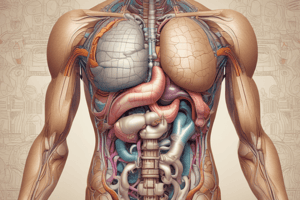Podcast
Questions and Answers
Which organ is responsible for the mechanical digestion by breaking up food?
Which organ is responsible for the mechanical digestion by breaking up food?
- Mouth (correct)
- Small intestine
- Liver
- Stomach
Which enzyme in saliva digests starch into maltose?
Which enzyme in saliva digests starch into maltose?
- Salivary lipase
- Pancreatic amylase
- Salivary amylase (correct)
- Gastric amylase
What is the primary function of the accessory digestive organs?
What is the primary function of the accessory digestive organs?
- Storage of digested products
- Production of digestive enzymes (correct)
- Mechanical breakdown of food
- Absorption of nutrients
Which part of the gastrointestinal tract is responsible for propulsion through peristalsis?
Which part of the gastrointestinal tract is responsible for propulsion through peristalsis?
Where does the absorption of digested products primarily occur?
Where does the absorption of digested products primarily occur?
Flashcards are hidden until you start studying
Study Notes
Digestive System Functions
- The stomach is the organ responsible for mechanical digestion by breaking up food through muscular contractions and mixing it with digestive juices.
- Salivary amylase is the enzyme in saliva that digests starch into maltose, initiating carbohydrate digestion in the mouth.
Accessory Digestive Organs
- Accessory digestive organs, including the liver, pancreas, and gallbladder, primarily function to produce and store digestive enzymes and substances, facilitating digestion and nutrient absorption.
Gastrointestinal Tract and Propulsion
- The esophagus and intestines are parts of the gastrointestinal tract where propulsion of food occurs through peristalsis, a series of wave-like muscle contractions that move food along the digestive tract.
Absorption of Nutrients
- The majority of nutrient absorption takes place in the small intestine, where digested products are absorbed into the bloodstream through specialized structures called villi and microvilli.
Studying That Suits You
Use AI to generate personalized quizzes and flashcards to suit your learning preferences.




